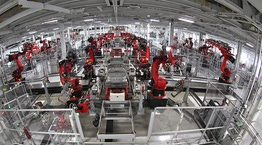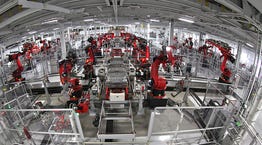Manufacturing 4.0 means more automation, more digital information and more connectivity
With the automotive industry at the head of the pack, selling 17.5 million vehicles in 2015, an increase of 5.7% over 2014, manufacturing is reinventing itself to meet new requirements and old challenges. Looking at automation, the Robotic Industries Association (RIA; Ann Arbor, MI) just released 2015 figures that show the North American robotics market also set a new record.
February 16, 2016

|
Image courtesy Steve Jurvetson/flickr. |
A total of 31,464 robots, valued at $1.8 billion, were ordered from North American companies during 2015, an increase of 14% in units and 11% in dollars over 2014. Robot shipments also set new records, with 28,049 robots valued at $1.6 billion shipped to North American customers in 2015. Shipments grew 10% in units and 9% in dollars over previous records set in 2014.
RIA credits the automotive industry as being the primary driver of growth in 2015, with robot orders increasing 19% year-over-year. Non-automotive robot orders grew 5% over 2014. Semiconductors and electronics was the leading non-automotive industry in 2015, with growth at 35%. The fastest growing applications for robot orders in North America in 2015 were coating and dispensing (+49%), material handling (+24%) and spot welding (+22%). RIA estimates that some 260,000 robots are now in use in North American factories, which places third after Japan and China in robot use.
The RIA notes that the performance of the robotics market is "concurrent with falling unemployment" (4.9% in January), meaning that robots are not taking over human jobs, which was confirmed in interviews I conducted with various automation suppliers for the upcoming PlasticsToday print issue. In fact, several processors pointed out the need for skilled labor to tend the robots.
Jeff Brunstein, President of RIA, noted that fact, as well: "Today there are more opportunities than ever before in the robotics industry. The continuing growth in robotics is opening many new job opportunities for people who can program, install, run and maintain robots. In fact, if you look closer at the jobs discussion, automation is helping to save and create jobs. A lot of companies tell us they wouldn't be in business without robotics and related automation."
We also need to remember that the labor participation rate of 62.7% is extremely low—the lowest since just prior to World War II. A lot of people who could be in the labor force are not, either because they cannot get full-time work or find a job that needs their skills. Indeed, many simply have given up looking for work. While 4.9%, in theory, indicates "full employment," things are not great in the manufacturing sector.
In a recent issue of the Vault, a newsletter produced by Siemens, it was noted that "data and data management have taken over several aspects of the manufacturing industry, and will continue to become important players in other sectors worldwide. Software data and connectivity have given rise to the digital enterprise, creating a sustainable competitive advantage for U.S. companies."
Additionally, that article, "With Automotive Leading the Way, U.S. Manufacturing Reinvents Itself to Transform the Sector," noted that "advanced manufacturing operations are more adaptive, productive and capable of delivering rapid innovation through industrial software that intelligently integrates data to help companies make smarter decisions and deliver better products . . . real-time information that continuously feeds a highly skilled workforce."
The need for a skilled workforce will always be present, no matter how much automation manufacturing plants install to improve productivity and quality, and alleviate the stressful, repetitive motions that tend to cause humans problems physically. It's not just automation that improves manufacturing—implementing smart automation benefits the company and its customers.
About the Author(s)
You May Also Like





